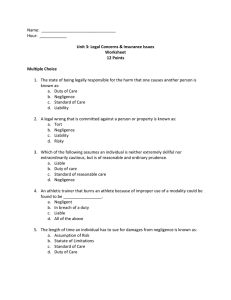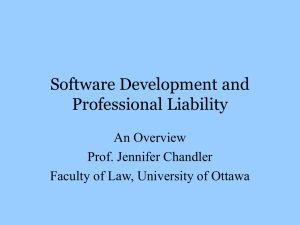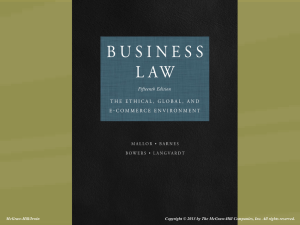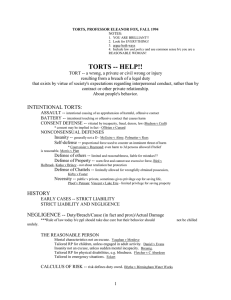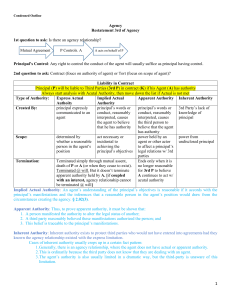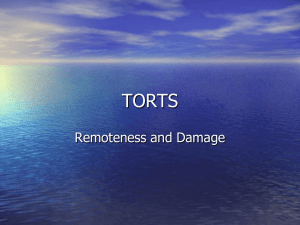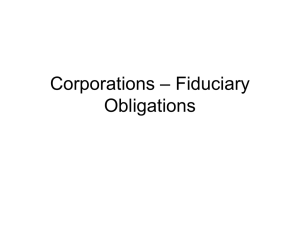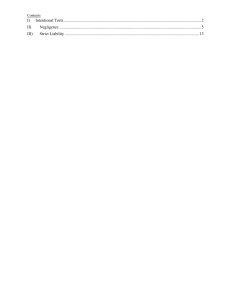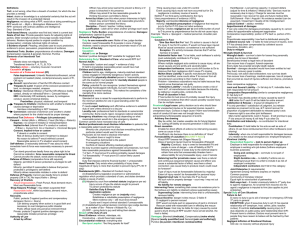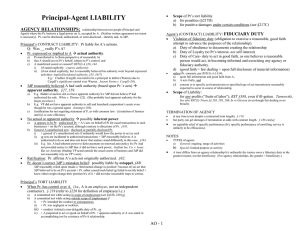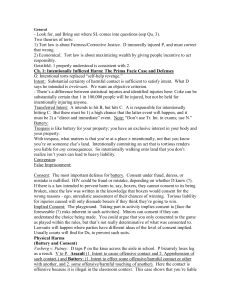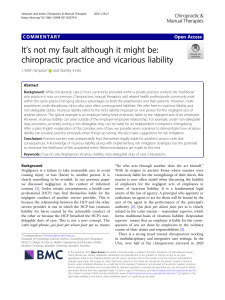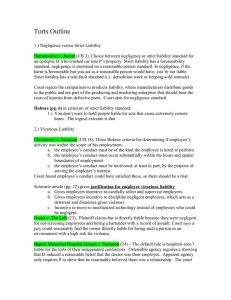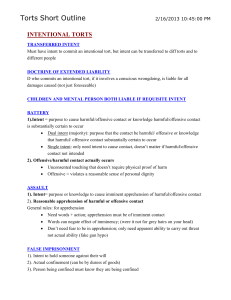Document 9828927
advertisement
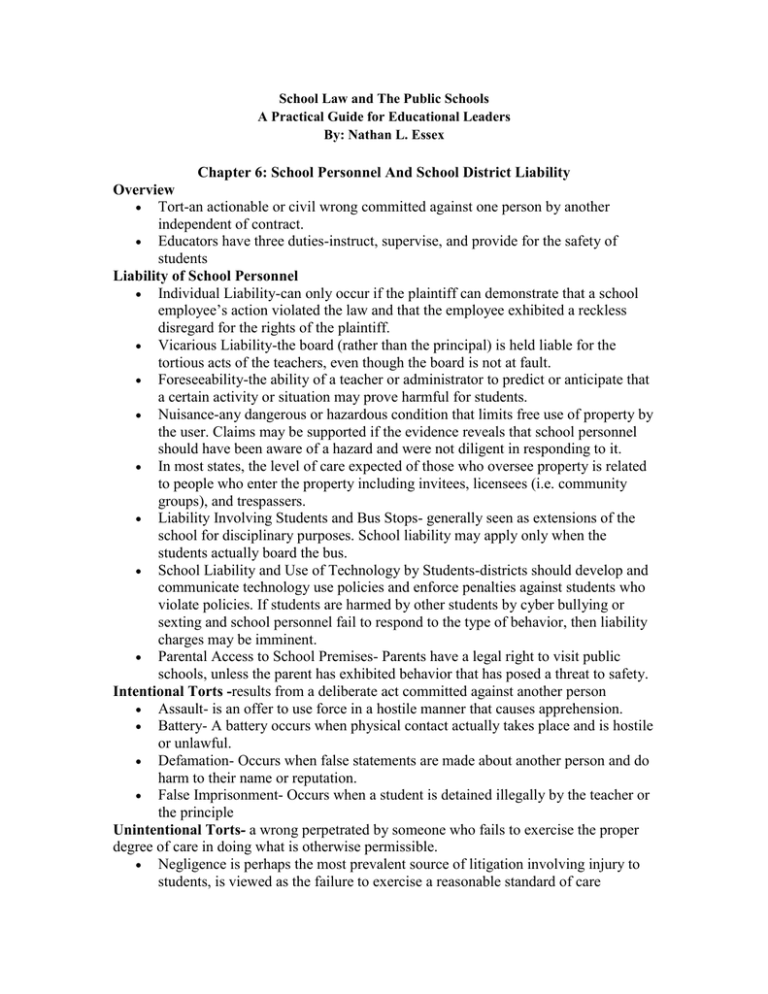
School Law and The Public Schools A Practical Guide for Educational Leaders By: Nathan L. Essex Chapter 6: School Personnel And School District Liability Overview Tort-an actionable or civil wrong committed against one person by another independent of contract. Educators have three duties-instruct, supervise, and provide for the safety of students Liability of School Personnel Individual Liability-can only occur if the plaintiff can demonstrate that a school employee’s action violated the law and that the employee exhibited a reckless disregard for the rights of the plaintiff. Vicarious Liability-the board (rather than the principal) is held liable for the tortious acts of the teachers, even though the board is not at fault. Foreseeability-the ability of a teacher or administrator to predict or anticipate that a certain activity or situation may prove harmful for students. Nuisance-any dangerous or hazardous condition that limits free use of property by the user. Claims may be supported if the evidence reveals that school personnel should have been aware of a hazard and were not diligent in responding to it. In most states, the level of care expected of those who oversee property is related to people who enter the property including invitees, licensees (i.e. community groups), and trespassers. Liability Involving Students and Bus Stops- generally seen as extensions of the school for disciplinary purposes. School liability may apply only when the students actually board the bus. School Liability and Use of Technology by Students-districts should develop and communicate technology use policies and enforce penalties against students who violate policies. If students are harmed by other students by cyber bullying or sexting and school personnel fail to respond to the type of behavior, then liability charges may be imminent. Parental Access to School Premises- Parents have a legal right to visit public schools, unless the parent has exhibited behavior that has posed a threat to safety. Intentional Torts -results from a deliberate act committed against another person Assault- is an offer to use force in a hostile manner that causes apprehension. Battery- A battery occurs when physical contact actually takes place and is hostile or unlawful. Defamation- Occurs when false statements are made about another person and do harm to their name or reputation. False Imprisonment- Occurs when a student is detained illegally by the teacher or the principle Unintentional Torts- a wrong perpetrated by someone who fails to exercise the proper degree of care in doing what is otherwise permissible. Negligence is perhaps the most prevalent source of litigation involving injury to students, is viewed as the failure to exercise a reasonable standard of care Standard of Care-requires that the school personnel exercise the same degree of care that other professional educators holding similar positions would exercise under the same or similar conditions. (Level of care due to student changes based on the age, maturity, experience, and mental capacity of students, as well as the nature of the learning activities in which they are involved.) Breach of Duty- Different school activities require various levels of supervision. The question is whether the behavior of the school employee met the standard of care required and if he or she could have foreseen possible injury. Proximate Cause- This is established if the evidence reveals that the employee’s behavior played a direct role in the injury incident. Injury-To establish liability, there must be evidence to show injury resulted from acts committed by a school employee or their failure to act. Defenses for Negligence Contributory Negligence- most common defense, when a teacher or administrator is charged and negligence is proven there are no monetary awards Assumption of Risk- most often seen with athletic teams, intramural activities, and pep squads. School personnel are still expected to foresee possible injury Comparative Negligence- Acts of those involved are compared in the degree of negligence, if one party is found to have contributed more injury than another, then they will be assessed a great amount of damages. If jury finds that both parties are equally responsible, neither party is assessed damages. Immunity-Government is protected and can’t be held liable for injuries resulting from government functions (includes school districts because they are agents of the state.) Immunity exists in a limited fashion in some states, but varies o Teacher/administrators may/may not be covered by immunity because they are responsible for themselves, this is why school personnel are advised to belong to their local educational association, membership carries liability protection Proper Instruction and Student Safety Standard of care for teachers of physical education, intramural sports, science, and vocational labs are higher because of the nature of the activities. Teachers have a legal duty to instruct on the proper use of equipment and materials. Duties of Supervision Before School o Reasonable measures have been taken based on foreseeable harm, age, and maturity of the students o Parents should be informed in writing that school personnel are not available during early morning hours to supervise o Administrators are responsible to ensure that the campus is safe for earlymorning arrivals After School o Not generally expected unless students engaged in a school-sponsored activity o Cannot ignore students when potentially dangerous situations are observed Should have well-developed policies addressing responsibilities of all stakeholders in situations involving after dark or exposure to unauthorized strangers During Field Trips o Parental Consent and Written Waivers-Forms have very limited legal basis, teachers still have a legal duty to supervise and ensure student safety o Field Trips and Buses-School District owned or commercial-line transportation should be used to transport students, not private vehicles o Educational Malpractice Educational Malpractice--any unprofessional conduct or lack of sufficient skill in the performance of professional duties Academic Injury--failure to meet minimal standards of instructional competency Professionalism in Education-Public policy is now focused on accountability of for educational outcomes, this may lead to more successful malpractice lawsuits. Landmark Cases Hosemann v Oakland Unified School District-Court ruled that the Oakland Unified School District have an affirmative duty to alleviate crime and violence on school campuses. Doe v Taylor-Court upheld that Administrators had a duty to protect students from hazards of which were known while under the school’s functional custody Wood v. Strickland- School board members may be individually held accountable for damages when they violate the constitutional rights of students. Carey v. Piphus-School violated 14th Amendment Rights of a student due to a lengthy suspension without due process. Francis v. School Board of Palm Beach County-Court upheld that schools boards are not insurers of school safety. Duty of care in regard to transportation extends from when a bus picks up the student at a bus stop to when they reach the school door. Gordon v Oak Park School District No. 97-Court held that a teacher has the right to yell or verbally chastise a student and would not be held liable. Celestine v Lafayette Parish School Board Case-Involved a teacher embarrassing a student by having him write a vulgar word 1,000 times in the presence of his peers as punishment for using it. The teacher was let go for using poor judgment. New Jersey v T.L.O.-This case upheld that a parent does not have to be notified during a period of detainment of a student. Mirand v.The City of New York & City Board of Education-Students were assaulted when leaving school while no supervision was being given. Failure to exercise due to care was very expensive for New York. Norman v Ogallala Public School District-Nebraska Supreme Court ruled that the district did not take the steps to adequately protect the student while using a welding torch because they did not comply with safety regulations. Titus v Lindberg- Court ruled that schools are responsible for students who arrive early, despite the time that they arrive, if they are aware of their presence. There is no set time frame when supervision has to occur. Peter W. v San Francisco Unified School District-This case involved a student who was reading at the 5th grade level upon graduation. Parents were told that he was near or at grade level, so they sued on the grounds of a misleading & bad education. The courts could not establish standards of care for classroom instruction and therefore could not rule in the parents favor. Hoffman v Board of Education-A student was placed in the wrong placement for special services. Student claimed he had diminished intellectual abilities because of this placement. The school district won. Application for Administrators and School Districts Educational Malpractice-Administrators need to ensure that they have developed quality standards of practice to guide student instruction and that they monitor these instructional practices. They need to make sound decisions when it comes to textbooks, curricula, and instructional policies. To make sure that all the necessary skills are being taught in the classroom, personnel needs to be prepared and trained. For those students who do not understand concepts, teachers must provide remediation and develop instructional strategies to reach the needs of all students. School Liability- Make sure school personnel understand the standard of care they must maintain and that they have a legal duty to instruct, supervise, and provide a safe environment for students. Policies involving conduct should be stated in the district policies, along with consequences for violations. Students should not undergo coercion, physical punishment, mental distress, or emotional harm from school personnel. Instead, schools should develop an environment that encompasses respect for all individuals. All personal information regarding students should be kept confidential and shared only with those that are directly working with that student. School personnel should provide supervision before and after school.
